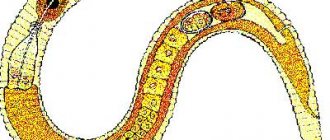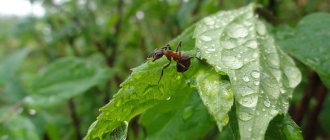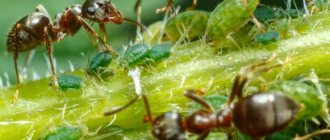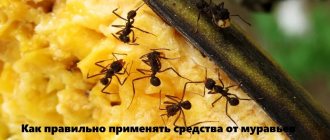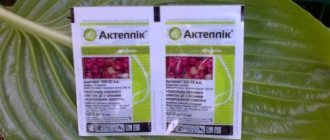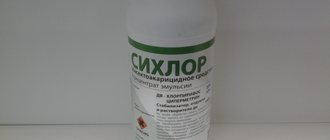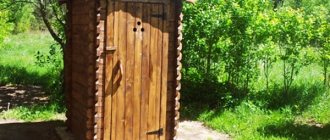“There are crowds of ants rushing around the garden - how many Anteaters does it take to flood everything?” – this cry from the heart of the participants of our portal is ready to support hundreds of thousands of owners of suburban areas in our country. Ants can really cause a lot of damage to your garden; they can also enter the house. We have prepared 10 cards that explain the dangers of ants and how to get rid of them.
What ants can live on the site?
There are about 300 species of ants in the regions of Russia. And the everyday concept of “garden ants” combines several of them. In summer cottages, the black garden ant and the red forest ant are most often found, and the house ant and the yellow garden ant are less common.
Red forest ant
This is a large insect about a centimeter in length. Such ants build huge anthills with impressive underground tiers. Aphids are bred, distributed and protected. They eat flowers of fruit trees and shrubs.
Black garden ant
A small black or dark brown aphid with a body length of only 5 mm, but it is the largest “breeder” of aphids. They can completely destroy seeds in the ground.
Earthen or garden yellow
Also small, up to 0.5 mm long. It does not breed aphids, but feeds on the fruits of fruit trees and berries. They build underground anthills and damage tree roots.
Brownie, aka, pest, aka, pharaohs, aka, ship ant
Having settled on the site, it quickly seeps into the greenhouse, house or outbuildings. Tiny, up to 3 mm long. He eats everything he can get his hands on, from kitchen cupboard supplies to pet food.
How to fight ants in the house and on the property using chemical methods
Chemical preparations are suitable for killing ants both in the house and in the garden. But it is recommended to use crayons or insecticidal gels in a house or apartment. Emulsion concentrates and powders are recommended for use outdoors.
- Coat ant paths, joints of wall tiles, and places where insects gather with Mashenka chalk or any other pencil. In case of serious infection, use gels - Absolute, Clean House, Raptor. The gel is applied where insects appear; do not spare the drug in places where ants accumulate. Poisoned workers will bring poison into the nest and destroy the entire colony.
- Products in powder form - Phenaxin, Thunder - 2, Delicia, are convenient to scatter in the yard, garden and vegetable garden. The powder is poured near the anthill, in places where aphids accumulate, on the floor or soil, where nimble insects scurry about, but the nest is not found.
What damage do ants cause to the site, besides breeding aphids?
- Acidify the soil. It is a scientific fact that ants secrete a substance that interferes with the growth and development of plants.
- They damage the root system of plants. The extent of the damage depends on the population.
- They destroy fruits and ovaries with a high carbohydrate content (if the ant population in the area is large, insects begin to feed on sweet fruits and berries), buds and petals of roses and peonies.
- They spoil the seeds and roots of seedlings. If there are a lot of ants on the site, the underground floors of the anthills go wider and deeper, and the ants begin to feed on seeds and roots that are located not far from their home.
- They spread weeds (drag their seeds around the area).
- They steal food products from a person and drag them little by little into their anthill.
How and why do ants breed aphids?
Aphids have thin skin, they constantly evaporate moisture, and are forced to continuously suck sap from plants. And just as a cow produces milk, aphids produce honeydew, which ants simply adore. Therefore, they care for aphids as if they were their pet: they transfer them to new, young and succulent plants, protect them from ladybugs and other entomophages, and take them to their anthills for the winter.
Ants and garden crops
Forest ants or black garden ants come to the territory of household plots and summer cottages. Both of them, under favorable conditions, are capable of quickly multiplying in geometric progression and in large numbers they no longer bring benefit, but harm.
By creating many anthills in different places of the site, they increase the acidity level of the soil, which has a bad effect on trees and bushes. In search of food and food, ants in garden beds often spoil berries and flowers.
Important!
The main problem is the creation of a symbiosis between ants and aphids, which they specially plant on garden crops in order to feed on their sweet secretions. These small green parasites are harmful to plants and can kill them in just a few days.
Symbiosis of ants and aphids
What is the best ant repellent?
Boric acid. Based on it, many baits are made with which the ants treat the queen, and thus the colony of ants not only moves to another place, but dies.
In the doses used for ant baits, boric acid is absolutely harmless to humans, animals and plants. Most good and expensive ant repellents from the store are made based on it.
In second place in terms of effectiveness is ammonia, but not ammonia, but ammonium chloride NH4Cl. It is harmless for people and a nitrogen fertilizer for plants. Sold in radio and electrical goods stores.
How to scare ants away from garden beds
Ants are very sensitive to odors. They are attracted to sweet smells, but they cannot stand aromatic herbs, for example, oregano, parsley, dill, mint, mustard, tobacco, valerian. These plants can be planted in beds - between rows of crops or along the perimeter. They will protect the plantings from ants. Also, insects do not like the smell of tomato tops, garlic, and celandine. Marigolds are also unpleasant for them, so you can repel ants beautifully by planting these flowers between the beds.
In addition to plants, these insects do not like the smell of coal and ash. These substances, in turn, act as fertilizer, so you can scatter ash or burnt coals over the beds. This will repel insects and enrich the soil.
But they say you can kill ants with yeast?
This is also a very good way:
- Finely chop the briquette of raw yeast,
- put sugar in them “volume by volume”,
- pour warm, but not hot water,
- mix,
- place saucers with this treat near the “ant points”.
The ants will be happy, grateful and will quickly drag the treat inside their nest, to other sweet supplies. And then the yeast will begin to ferment and destroy all the ant food. After this local humanitarian catastrophe, the colony will die out.
Is it possible to get rid of ants in your summer cottage with a soda solution?
No. But their numbers can be reduced. The ants will most likely leave this place, but will settle in another. But try it if you want: pour 2 tablespoons of baking soda into a regular 1.5 liter plastic bottle, fill it to the top with hot water, and shake until the soda dissolves. Pour the entire bottle into the “ant point” and cover it with sand on top. You can simply sprinkle the ant areas with soda, or soda mixed with mustard powder. Upon contact with soda, the ants die.
How to drive ants out of a greenhouse?
This is a difficult task; The greenhouse is usually inhabited by brownies, also known as Pharaoh's ants, the most tenacious and cunning. To solve it, you need:
- Find the entrances to the ant nest (track the ants along the paths). The entrance will be under the heating pipe or irrigation system, at the frame rack, etc.
- Take a piece of natural felt (ideal) or any moisture-absorbing fabric (good) the size of a small plate.
- Put on a respirator, safety glasses and drip ammonia from the bottle onto the felt or cloth to completely wet them.
- Place it at the entrance to the anthill, cover the top with a piece of polyethylene. Keep windows and doors to the greenhouse open.
- If necessary, repeat treatment after two weeks.
conclusions
The main thing in the fight against ants on the site is consistency (they will return and you will have to start all over again), integrity (there should be only one owner on the site) and an understanding of how the ant family works. We do not recommend practicing methods that simply drive ants away from the site. It is important to destroy the queen, and then the ant colony will come to an end. The FORUMHOUSE consultant, an agronomist with the nickname Sodmaster, also thinks the same.
Sodmaster
Destruction of ants is of no use if the queen is alive, which in a short time can give birth to a new retinue. The queen does not feed herself; she is fed by worker ants. Now, if you add poison to what they feed her and kill the queen, then the worker ants will scatter or die, deprived of leadership and a national idea. Gel and poisoned baits work precisely on this principle. Ordinary boric acid with sugar syrup does not kill immediately - the ant manages to bring the “delicacy” to the queen, who, having got drunk, dies in agony.
There are quite a few ways to fight ants, and each case has its own. All of them are discussed in our forum thread “How to get rid of ants-2”. Find out how to get rid of ants in your home. Read our article about how ants can be not only enemies, but also helpers for the gardener. Watch a video about how to set up a light garden in which even pests will not particularly bother the plants.
Effective ways to fight with folk remedies
To combat ants in the garden, a large number of synthetic chemicals and time-tested folk remedies are used. The latter demonstrate effectiveness that is not inferior to professional insecticides. Home methods are environmentally friendly and widely available. Do not harm the soil and cultivated plants. These methods include:
- treating nests with boric acid;
- using a mixture of oregano and wood ash;
- destroying an anthill with kerosene;
- watering areas where pests are concentrated with vegetable oil.
Interesting! Some summer residents fill nests and places where pests are concentrated with boiling water. It is better to carry out the procedure in the evening.
Boric acid
This antiseptic substance, used to disinfect open wounds, is the best remedy for ants in the garden. Boric acid is a reliable natural insecticide. To destroy a colony of insects, it is mixed with sugar dissolved in hot water. The nursery and dug passages are flooded.
Transfer
A humane option is to move the anthill outside the boundaries of the cottage or another cultivated area that has been invaded. To relocate a small nest, you will need a scoop and a shovel. It is dug up and transported to another location. An important point is that ants prefer to build their homes in sunny places. If you provide forced shade, the pests will go away on their own.
Attention! It is impossible to get rid of a perennial and deep anthill in this way. It can neither be tolerated nor survived by an artificially created deficiency of solar radiation.
Kerosene
A remedy tested for generations against garden ants is kerosene mixed with water. This solution can easily poison even a large colony of insects. Dilute 10 tablespoons of kerosene per 10 liters of water. Water ant passages and places where insects are concentrated.
Boiling water and vegetable oil
At dusk, when the ants return to the nest for the night, it is dug up and irrigated with boiling water with sunflower oil dissolved in it. The pile needs to be stirred up well. Then the disinfestation procedure will give the proper result. The queen and larvae are destroyed.
Soap solution
This is the safest and easiest way to rid your summer cottage and house from an invasion of ants. Soap suds, getting on the pest’s body, blocks the penetration of oxygen into the skin. As a result, the individual dies. To implement this plan you will need:
- 10 liters of water.
- 100 gr. liquid soap.
The recipe is simple - mix the ingredients and pour into a container with an aerator. It is advisable to spray areas where pests are concentrated in the evening. The dried soap suspension forms a thin film that is harmful to insects.
Borax solution
A mixture of boric acid and soda, called borax, is toxic and can poison even a large family of ants. The poison is prepared from the following components:
- water;
- bait sweetener;
- teaspoon of borax.
The nursery is watered with the chemical. The product is distributed over tin or nylon covers and placed on paths where ants crawl.
Important! If pests die near the bait, it is necessary to reduce the concentration of the poison. The desired effect is the death of the ant in the nest, where its body will be eaten by other individuals. This will solve the problem of population reproduction radically.
Yeast
They are used both in granular form and fresh. The dry product is sprinkled on an ant heap, which causes the death of common pests and the queen. Treating with yeast is an effective way to poison even a large nursery. Any sweets are used as bait.
Ammonia
This toxic substance is often used to kill garden pests. This radical method allows you to eliminate an anthill of any size. You need to stir up the nest, adding ammonia along the way. It is diluted in water in a ratio of 1:100. Ash or lime is added to the mixture. The solution serves as fertilizer for garden trees, and the ants die or leave.
Read the article here to learn how to kill ants using ammonia.
Millet and semolina
Some food products help remove ants from your garden plot. These include:
- millet;
- semolina;
- corn flour.
When grains of bulk household supplies enter the insect's stomach, they swell, which leads to the death of the individual. Depending on the size of the anthill, 2–3 kg of product is enough.
Vinegar and soda
Using baking soda is a proven method of killing pests. The secret of success lies in the chemical reaction that occurs between this substance and the acid that is in the insect’s body. Vinegar is a mixture that is harmful to pests, but safe for soil and plants. The sweetener that attracts ants is powdered sugar.

